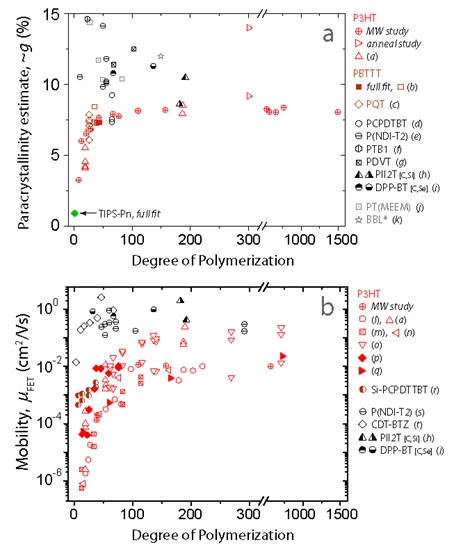The potential for combining low-cost manufacturing and mechanical robustness with engineering of specific opto-electronic properties has recently spurred great interest in semiconducting polymers. Consequently, devices based on organic semiconductors have reached significant milestones such as ~10% solar power conversion efficiencies as well as electron and hole mobilities exceeding 1 cm2/Vs. Conjugated polymer chains have many degrees of conformational freedom and interact weakly with each other, resulting in complex microstructures in the solid state. Understanding charge transport in such systems, which have both amorphous and ordered phases exhibiting varying degrees of order, has proven difficult due to the contribution of electronic processes at various length scales (Fig. 1). Using a combination of techniques applied to new and previous data, researchers from Stanford University, ETH Zurich (Switzerland), Imperial College London (UK) and SSRL have recently shown that trapping of charges caused by lattice disorder is the limiting charge transport step in high-molecular-weight semiconducting polymers, and that short-range intermolecular aggregation (as opposed to crystalline order) is sufficient for efficient long-range charge transport.

The researchers performed electro-optical measurements, demonstrating that charges move in the ordered regions (i.e. aggregates) of the heterogeneous microstructure in polymer films. The degree of crystalline quality of these ordered regions was quantitatively studied with X-ray diffraction at SSRL Beam Lines 11-3 and 7-2. These data revealed that all studied high-molecular-weight semiconducting polymers exhibit a large amount of paracrystalline disorder irrespective of their chemistry or overall degree of crystallinity (Fig. 2). This structural disorder is due to local fluctuations in the molecule-molecule spacing and is linked to the localization of electronic charge carriers within the molecular aggregates and to electronic traps. These traps limit charge transport in high-mobility, high-molecular-weight conjugated polymers.
The researchers conclude that the unifying requirement for high carrier mobility is the presence of aggregates that are interconnected, even if the aggregates are small and disordered. The key to designing high-mobility polymers is not an increased crystallinity but rather an enhanced tolerance to an inevitably large amount of molecular disorder within the aggregates by allowing more efficient intra- and intermolecular charge transport and transfer. This generalization explains the seemingly contradicting high performance of recently reported, poorly ordered polymers and suggests molecular design strategies to further improve the performance of future generations of organic electronic materials.

R. Noriega, J. Rivnay, K. Vandewal, F. P. V. Koch, N. Stingelin, P. Smith, M. F. Toney, A. Salleo, “A general relationship between disorder, aggregation and charge transport in conjugated polymers”, Nat. Mater., Advanced Online Publication (August 14, 2013), DOI: 10.1038/nmat3722.




